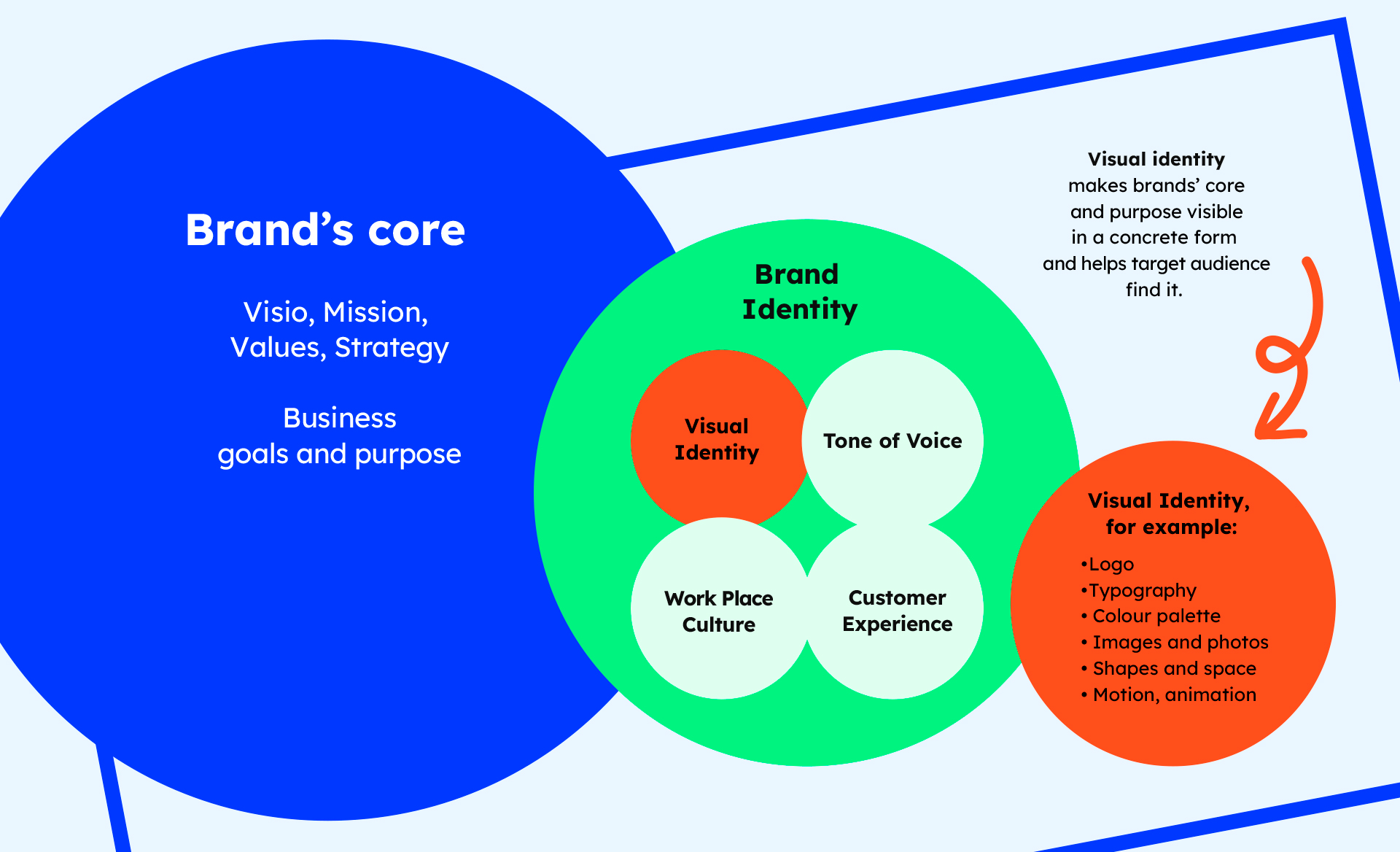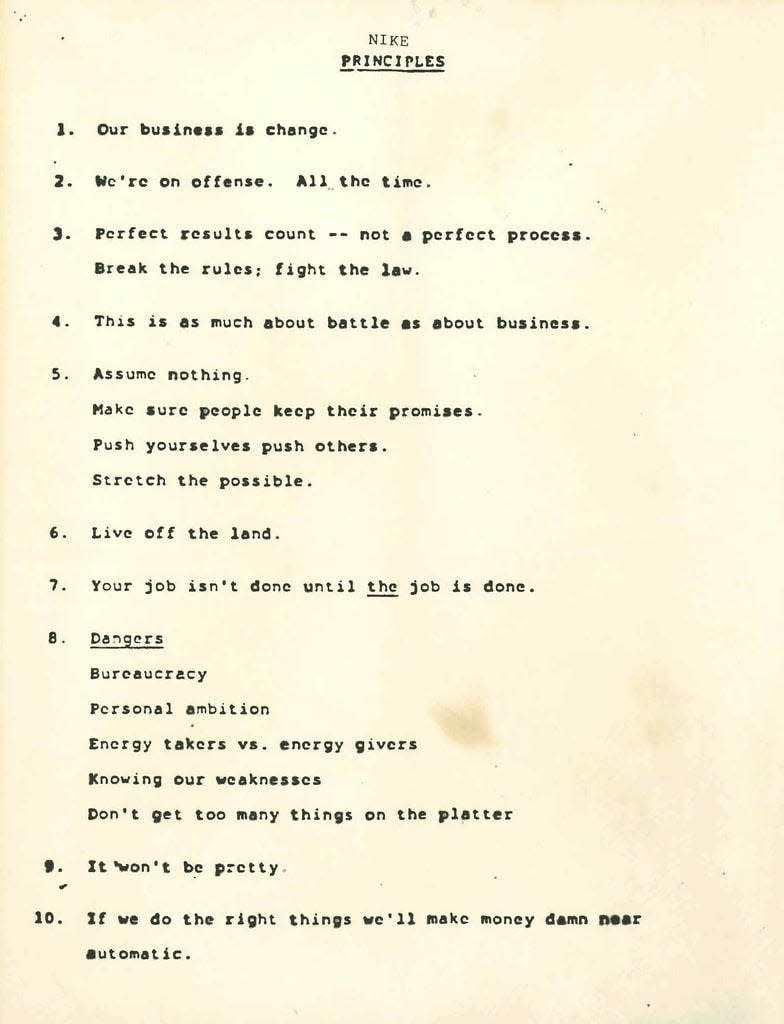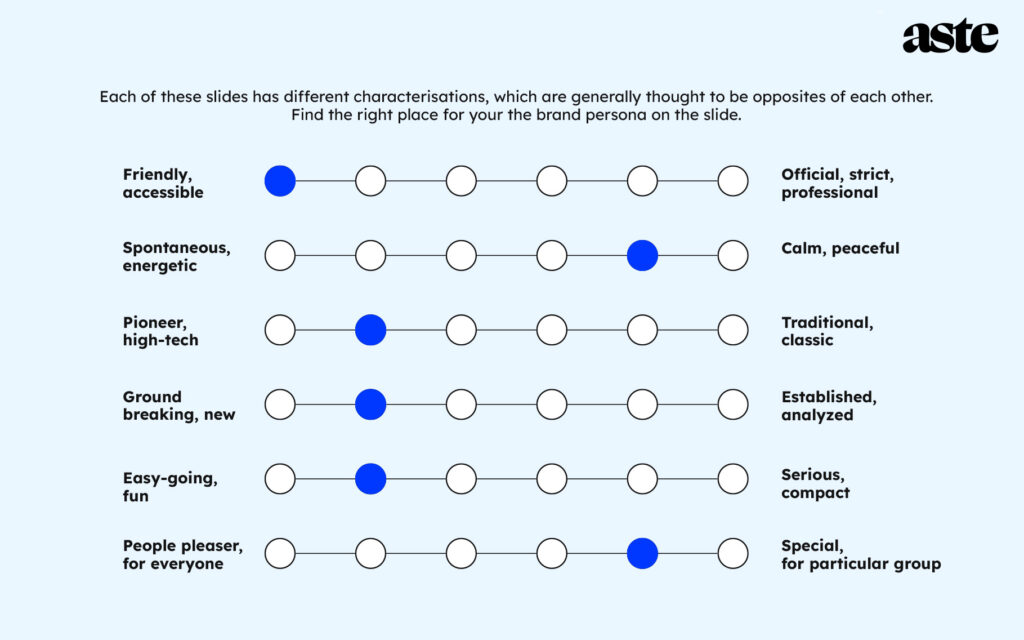Strong brand identity is your superpower

Brand identity – the sum of many things
Expensive TV advertising can get you a lot of exposure, but what happens when the campaign ends? Will your customer still remember you a week or a month later?
A strong brand identity is one of a company’s most important assets. It is not just a logo or a catchy slogan, but is built on many different things:
- Visual identity: logo, typography, colours, imagery…
- Ton of voice: how your company communicates to its customers and stakeholders.
- Work place culture: what values and practices guide the way we work together.
- Customer experience: how customers feel about their encounters with your company.
“Brand identity should always be built on the company’s strategy and goals. First, we look for the answer to why we exist, and only then do we think about how to make it visible to others,” says Jenni Kiviniemi, Product Manager at Aste.
“If you start building an identity or redesigning a look and feel directly from the visual identity without a rationale, it can feel overwhelming. It can then be difficult for both customers and the company’s own employees to truly feel ownership of the brand.”

5 reasons why a brand identity is vital
What difference does the font or tone of voice of a brochure make to the success of your business? It may not bring in individual sales, but when you build your brand consistently, it starts to show in the long run.
Through brand identity:
- Differentiate yourself from your competitors
Today’s market is highly competitive, and generic content production is easier than ever. When your brand has a coherent identity based on mission and values, it stands out more from the crowd.
Apple, for example, is known for its minimalist design and user-friendliness, which clearly distinguishes it from other tech companies.
“We are all in the midst of a lot of fuss and information overload. That’s why it’s not necessarily a good idea for a company to compete on quantity, but on quality and differentiation,” says Jenni.
“You should always assess whether an advertisement or other content really supports your brand identity or whether it is just a drop in the ocean.” - You inspire confidence
Customers feel secure when buying products or services from a company with a trustworthy and consistent brand.
Starbucks, for example, has built a recognisable brand that is repeated in exactly the same way around the world. Customers can count on always getting a familiar coffee with a familiar formula – in any city.
Aste works a lot with journalism, and its partners include some of Finland’s best-known newspaper brands and publishing houses. As technology and artificial intelligence have radically changed content production over the past few years, trust has become increasingly important, especially in the media sector.
“In the future, it may be difficult for consumers to tell whether content is produced by a machine or a human. It may be that trust in the brand will be the only thing that matters.” - Get more engaged customers
Branding always starts from the inside: from the mission, the goals, and the strategy of the company. Through your brand identity, show the customer what your company stands for and what it believes in.
When people share the same values and identify with a brand, they are more likely to want to buy the company’s products or services – and stay loyal customers for longer. Understanding your target audience strengthens your brand.
Nike, for example, sells not just sportswear, but a lifestyle and an attitude that customers want to commit to. Patagonia, on the other hand, emphasises sustainability, which attracts environmentally conscious customers. - Making everyday life more (cost) efficient
Thorough groundwork will pay off – again. Having a clear brand identity, a set of do’s and don’ts and a template for recurring concepts makes everyone’s life easier and faster.
“The experience of almost every IT worker is that they are always busy and their desks are full of work. It makes everyday life easier when you don’t have to reinvent the wheel every time,” says Jenni, a graphic designer.
For example, a magazine’s repetitive story types and valid folding bases speed up consistent production. And it’s much easier to come up with content for a company’s magazine when you can draw on brand values or brand messages. - Make decisions easier
A well-thought-out brand identity not only makes it easier to do things repeatedly, but also to try something new.
For example, if a company decides to go for a slightly bolder advertising campaign, it will be easier to justify its appropriateness if boldness and distinctiveness are defined in the brand identity.
“Then, too, you might not be so easily scared by the first feedback from the campaign, because it was a conscious, branded choice.”

(Source: danielscrivner.com)

Brand guidelines to help you in everyday life
A brand book (brand manual or brand guidelines) can be a pdf file or a website, for example, in which all the issues related to brand identity are recorded. In addition to a general handbook, it is also useful to create more specific guidelines for specific needs, such as a UI/UX (design system) guideline focusing on user interface and code solutions for online services.
“In addition to verbal instructions, it is worthwhile to provide lots of models and examples. This makes it easier to quickly visualise the guidelines and internalise the information, especially if several people or partners are involved in producing the content and materials,” Jenni advises.
Often there are many different pairs of hands working on a brand, which is why it is particularly important to have a good summary of what the brand looks and sounds like. It clarifies a common image of the brand and thus makes everyday life easier, regardless of the job description. In addition, a brand manual is an easy way to share all the necessary information with new authors or partners.
The rise of AI-assisted content production has also made written brand guidelines more important than ever. High-quality outcomes require that the AI is given as much background information and definition as possible, for example about the content’s objectives, target audience, brand values or visual identity. Otherwise, the end result is a bit of a guessing game.
Consistent living brand
A strong and distinctive brand identity is built up gradually through a sustained and consistent effort. So it pays to keep a certain line from day to day and campaign to campaign. On the other hand, the brand needs to be constantly maintained, updating the identity as business needs change or adding to the guidelines.
“You can think of a brand as a living organism that reacts to changes in the environment but is never entirely in its own hands. Brand guidelines and common policies should always be kept up to date, thereby also strengthening internal ownership of the brand.”

Read more Get your message seen and heard across multiple channels in a cost-effective way – Here’s
Text: Maija Vaara, Aste Helsinki
Experts










